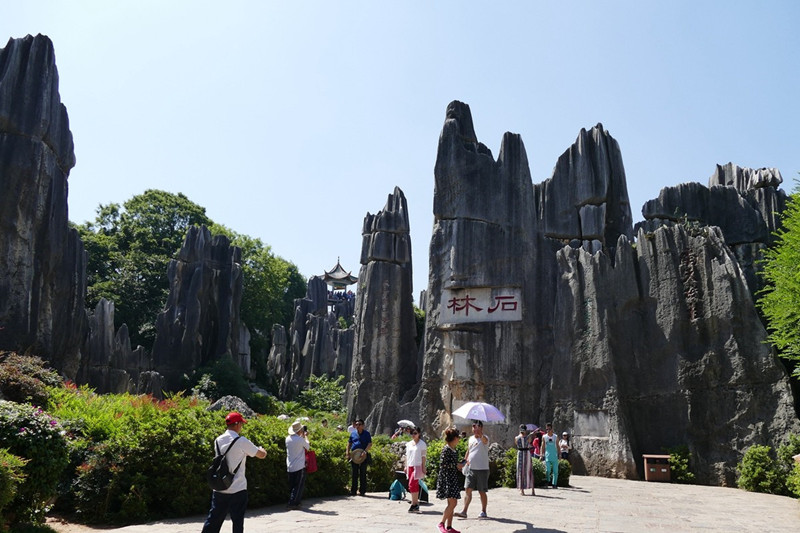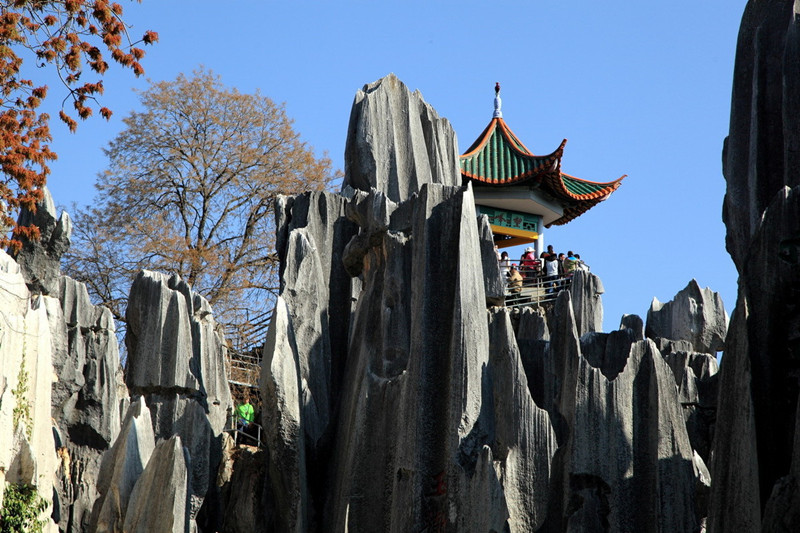 alt="Dali Erhai Lake Ecological Corridor from Xiaguan to Taoyuan"
/>
alt="Dali Erhai Lake Ecological Corridor from Xiaguan to Taoyuan"
/>
The Stone Forest, Kunming

Chinese Name: 石林
English Name: Stone Forest
Type: Geologic Formations, Points of Interest & Landmarks, Nature & Parks, Sights & Landmarks
Best Time: All Year Around
Recommended Visiting Hours: 1 Day
Opening Hours: 08:00 ~ 17:00
Location: About 78 kilometers away from Kunming City.
Why is Stone Forest so special?
The most dramatic of these attractions in Kunming is the Stone Forest, known since the Ming Dynasty as the ‘First Wonder of the World’. An old local saying says that ‘If you have visited Kunming without seeing the Stone Forest, you have wasted your time.’ Obviously, ranking the first at its age, size and typical formation, the Stone Forest is one of the most important attractions of Yunnan.
Introduction
History of Stone Forest
Geographically, the Stone Forest is a special topography called Karst landform, which is mainly formed by the chemical reation that limestone can be eroded by water with carbon dioxide. The specific formation of Stone Forest can date back to about 270 million years ago. At that time, this area was a part of ocean in which many oceanic living beings inhabited. As time went by, the corpses piled up gradually and fossilized into a thick limestone seabed, which rose up to form a table land because of the movements of the earth’s crust. Then a large number of lava from volcanoe eruption covered the limestone and cooled down, forming a thick basalt protective layer consequently. About 50 million years ago, the basalt layer flaked away and the water from rainfall and underground slowly eroded the limestone surface.
Main Attractions in Stone Forest
Walking through the Stone Forest, visitors marvel at the natural stone masterpieces and are bewitched by the intricate formations. The magnificent, strange and steep landscape creates countless labyrinthine vistas, including:Major Stone Forest, Minor Stone Forest and Naigu Stone Forest, all of which feature stones in various formations. Animals, plants, and even human figures can be found here. Some are elegant, some are rugged, and each is lifelike with its own distinguishing characteristics.
● Minor Stone Forest(小石林)
The Minor Stone Forest is also call Ashima Scenic Area. The big and thick stone walls like a screen deliver this scenic area into several parts. Of all, the most famous scenic spot is ‘Ashima’. When the night comes, it is colorful and charming under the glittering lights.

● Major Stone Forest(大石林)
The Major Stone Forest consists of intensive stone peaks, just like a stretch of stone basin. The stone forests here have straight shapes and smooth lines, among which the highest stone pillar is more than 40 meters in height.The magnificent, strange, and steep landscape creates countless sights, including Lotus Peak, Ashima Rock, Sword Peak Pond, Shilin Lake, and ‘a Gleam of Sky’.

● Long Lake (长湖)
Long Lake is a karst lake that is three kilometers (two miles) long but only 300 meters wide. The lake features underwater stalagmites and stalactites and a small island in the center of the water.The source of the Dadie Waterfall, Ba River, is a branch of Nanpan River. In the rainy season, up to 150 cubic meters (196 cubic yards) of water per square inch plummet down the 88 meter (288 feet) drop.
Legend & Minority Culture
Story about Ashima
Many beautiful legends originate in this magical place, passed along by the native people known as Sani, a branch of the Yi ethnic group. One particular story about the faithful love of Ashima, a beautiful, clever and warm-hearted Sani girl, is the most popular and has been told for thousands of years. As the legend goes, Ashima was kidnapped by an lanlord’s son and forced into marriage. Her lover, Ahei, made every effort to save her. However, on the way home, Ashima was swept away by a flood and turned into what is known as the Ashima Rock, which can be found in the Minor Stone Forest. Her passion and perseverance for freedom and true love still encourage today’s Sani people.
Torch Festival of Sani People
The Sani people celebrate their national festival – the Torch Festival – every lunar year on June 24. They take part in traditional performances such as wrestling, bull fighting, pole-climbing, dragon-playing, lion-dancing and the A-xi Moon Dance. During this time, the Stone Forest is alive with a particular0ve atmosphere, making the area even more attractive than usual.
How to Get There
Stone Forest is 78km from Kunming. Travelers can take public coach at bus stations in Kunming to Stone Forest. This will take about 1.5 hours. From Kunming Changshui International Airport, travelers can take the travel bus to there, and it will take about 2 hours. Shilin Yi Autonomous County also has a train station, and it has trains to Kunming, Shanghai, Guangzhou, Nanning, Zhanjiang, Guiyang, Hongguo, etc. Shilin Train Station is only about 4km from Stone Forest, so traveler can get the spot easily.
Another way to get to Stone Forest is taking a private car, and this is the fastest and most convenient way. It only takes about 1 hour. If you book tour with us, we will provide you the private car with a private driver and a tour guide to make your trip worry-free.
How to Get Around in the Park
Travelers will purchase the ticket at Visitor Center which is 2km from the entrance of the scenic area. Travelers can take cable car to from the Visitor Center to the entrance. The cable car will also drive in the scenic area (since the scenic area is quite large) and it will pass by all five attractions of Stone Forest Scenic Area, including Major Stone Forest, Minor Stone Forest, Bushao Hill, Lizi Yuanqing and Eternal Mushroom. Once purchase the cable car ticket, travelers can take any cable car in the scenic spot by showing the ticket in the same day.
Naigu Stone Forest is 8km from Stone Forest Scenic Area, and traveler can take the travel bus commuting between the two areas to there. The running time for the travel bus is 9:00 ~ 19:00 and it will departure every half hour. Please check with the working staff for the detailed position of the bus.
Recommended Stone Forest Tours
Top 3 Stone Forest tours chosen by most customers to explore Stone Forest in the best way. Check the detailed itinerary, or tailor your own trip now with us. We provide some tour routes for tourists to choose.
1 Day Kunming Stone Forest Group Tour
1 Day Kunming Stone Forest Tour by High Speed Train
1 Day Kunming Stone Forest Tour with Nuohei Ethnic Village Discovery
Useful Travel Tips
Torch Festival
June 24th in Chinese lunar calendar is the traditional Torch Festival of Yi people. At this time, Stone Forest will hold grand bullfight, wrestling and song and dance activities to celebrate. Yi people will dress in their traditional costumes to anticipate the celebration. At nightfall, the bonfire and torches will be lit up, and people will dance and sing around the bonfire. This is the best time to experience the ethnic culture of Yi people.
Best seasons
Best time to visit is from March to October. Most ethnic festivals are during this time, and travelers can also appreciate various flowers during this time. Stone Forest is located in the subtropical humid monsoon climate zone, and it features in continental monsoon climate. No hot summer nor severe cold winter, the climate here is rather moderate all year round.
Tickets
The entrance ticket for the Stone Forest and The ticket for cable car in the scenic area are not free. The dance show in the scenic area is free.
Facility
In the front of the scenic area, there are parking lot and China post office.
The Visitor Center can provide wheelchair, baby carriage, umbrella, walking stick, etc. for visitors.
The Visitor Center also provide tour guide service in Chinese, English, Japanese, Thai, etc. for tourists, and the guide service will charge a certain fees, please check with the staffs in the Visitor Center for detailed price.
Tourists can find the location of toilets in the scenic area according to the infrastructure map on the back of the entrance ticket.
Accommodation
Travelers can stay overnight in Shilin County after visit, and there are also some 3-star hotels in the county. However, most travelers will choose to go back to Kunming for accommodation. Kunming has more choice for travelers and it’s more convenient to transfer to your next destination from Kunming.


 7 Days GolfingTour
7 Days GolfingTour
 8 Days Group Tour
8 Days Group Tour
 8 Days Yunnan Tour
8 Days Yunnan Tour
 7 Days Shangri La Hiking
7 Days Shangri La Hiking
 11 Days Yunnan Tour
11 Days Yunnan Tour
 6 Days Yuanyang Terraces
6 Days Yuanyang Terraces
 11 Days Yunnan Tour
11 Days Yunnan Tour
 8 Days South Yunnan
8 Days South Yunnan
 7 Days Tea Tour
7 Days Tea Tour
 8 Days Muslim Tour
8 Days Muslim Tour
 12 Days Self-Driving
12 Days Self-Driving
 4 Days Haba Climbing
4 Days Haba Climbing
 Tiger Leaping Gorge
Tiger Leaping Gorge
 Stone Forest
Stone Forest
 Yunnan-Tibet
Yunnan-Tibet
 Hani Rice Terraces
Hani Rice Terraces
 Kunming
Kunming
 Lijiang
Lijiang
 Shangri-la
Shangri-la
 Dali
Dali
 XishuangBanna
XishuangBanna
 Honghe
Honghe
 Kunming
Kunming
 Lijiang
Lijiang
 Shangri-la
Shangri-la
 Yuanyang Rice Terraces
Yuanyang Rice Terraces
 Nujiang
Nujiang
 XishuangBanna
XishuangBanna
 Spring City Golf
Spring City Golf
 Snow Mountain Golf
Snow Mountain Golf
 Stone Mountain Golf
Stone Mountain Golf













 What Our Customers Say?
What Our Customers Say?
